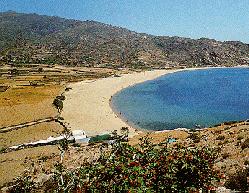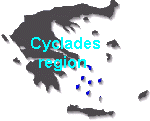| IOS |
 |
 |
This description provides information of ancient sites, seaside resorts, churches, monasteries, landscapes and small towns and villages. Additional details can be found in various books printed on Greece, such as the 'Blue Guide to Greece.' The names of places conform to the accented Greek pronounciation which would be the one a traveller would face upon a potential visit.
For a general map of the Kyklades, click here!(55K).
To go back to the Kyklades main page, click here!
Ios is the up and coming island of the Kykl�des. More and more tourists come here; there is great infrastructure for development which, coupled with many hotels, crystal-clear waters and many amenities make it a perfect choice. All it needs is an airport and then it is set for the future!
The island is mountainous and has an area of about 105 square kilometers and is 18 km long (12 miles) and 7 km wide (about 4.5 miles). The tallest peak is P�rgos at an altitude of 732 meters.
The island, called Nios by the locals, was also named Phoen�ki, by the Phoenicians who lived here. The name Ios comes from the phoenician word meaning place with stones, a good description of Ios today. The Ioanians took over the island around 2000 BC. Subsequently, Ios paid taxes to the Athenians, which was one T�lant. The Romans took over the island under their Island Province (Provincia Insularum).
In 1207, Ios came under the control of nearby Naxos island, and in 1397, the island was inherited by Marcos Kr�spos who built the castle and brought in immigrants from Asia Minor. In 1508, the island was given as dowry to the daughter of Marcos Adrian� who married the Venetian Pizani.
During the war of independence, the island played an important role with Panagiotis Amoira�dis, raising the Greek flag.
TransportIn the summer there are more than 2 ferry boats per day to Ios from Piraeus, which takes 8 hours (info: 01/ 4226000). From Rafina there are additional crossing with Flying Dolphins (info: 01/4224772). You can visit the island from other islands in the summer (info: 0286/91264).
GIALOS
The main port of call for the island, littered with whitewashed houses. Beautiful beach and plenty of snorkerling opportunities in the rocks nearby. The church of Ag�a Eir�ni is evident as is the golden beach nearby.
HORA
The main town of the island, full of hotels and places to stay, many windmills and clubs and restaurants. It is becoming a new Mykonos. Myriads of white washed houses, coupled with many churches are seen everywhere.
PLAKOTO
This is the site of the alleged tomb of Homer. In the Russian naval brigade, controlled by the masters Spir�don and Orlof, a dutchman, called Pasch van Krienen, was the representative of his Government. He took the opportunity and visited many of the Kykl�des islands. In Ios, he discovered many ruins dedicated to the gods of Zeus, Athena, Poseidon and Pithian Apollon. They were all worshipped here. Based on a Heredotous decsription on Homer (the book: Herodotous V�os Om�rou 34), he realised that the tomb under a square tower must be that of Homer. Even though this story has alternate endings, the British shipping chart also indicates Homer's tomb as originally indicated by Van Krienen. The Tradition that Homer rests on the island, also has to do with the coins that were minted here around 200-300 BC.
|